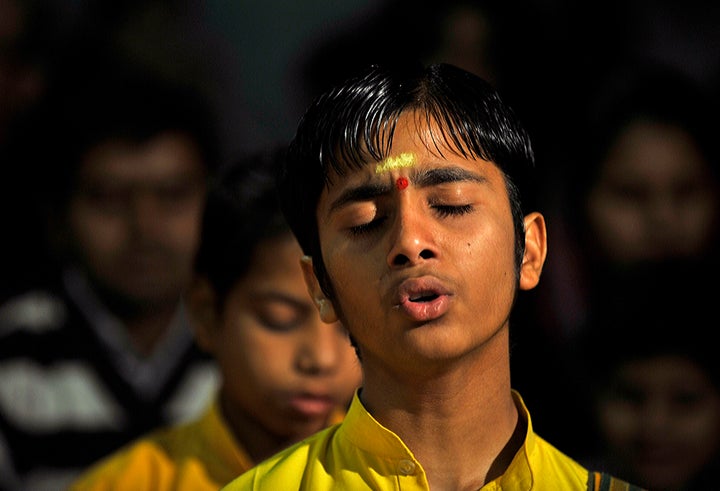
Science and spirituality are the foundation of the Hindu culture, celebrating the divine qualities with pageantry. The core belief of Sat-Chit-Anand (Truth-Consciousness-Bliss) emphasizes everything exists in God and emanates from that One. The Vedantic Hindu philosophy brings out these expressions of divine through allegorical stories (puranas) and into societal cultural life through festivals, aligned with the rhythm of nature.
In the cycle of life, in thought, action, word or deed, there is a beginning, a middle and an end. Actions in each of the 3 stages require energy to complete them. Hence, our symbolic Trinity, Brahma = generation or creation requires right knowledge (Saraswati), Vishnu = operation or sustenance requires resources of all kinds (Lakshmi) and Shiva = constructive destruction requires tremendous energy (Parvati).
Through the allegorical stories in the Shiva Mahapuranas, the Rishis (learned sages) have brought to life the yogic qualities, such as detachment and inner development, of the first Guru. The puranas in the parlance of the common person, say on this day Shiva and Parvati married. A union of constructive destruction requires tremendous energy for renewal! Pruning is essential for growth.
Maha Shivaratri is celebrated every year on the 13th night and 14th day in the Krishna Paksha (waning moon) of the month of Magha or Phalguna (February-March) in the Hindu Calendar (that is, the night before and the day of the new moon). Pruning ends; renewal begins.
Maha Shivaratri observes the restful period of Shiva after the Tandava (Cosmic) Dance and a new beginning. Shiva symbolizes removal of negativity of life (Shiva in reverse is Visha which means poison. Hence, Shiva, as the opposite, is life giving. Without the "i" which represents feminine strength Shiva spells Shava or a lifeless form. Energy is required to keep the body alive).
A picture is worth a thousand words. A deity symbolizes many Vedic aspects. The divine dance of Lord Nataraja, Lord of Dance, signifies the yogic process of self realization.
In the cosmic 'Dance of Bliss' Anandatandava, Shiva as Nataraj, on the stage of the world and the heart of the seeker, represents life activity through the dance of the Omniscient God. The dance symbolizes the cosmic cycles of creation and destruction, and the daily rhythm of birth and death.
In perfect yogic balance, He is crushing the dwarf-demon of forgetfulness of one's own innate divinity (Apasmara); i.e. removing living in the duality of cause and effect with resulting misery and suffering. The Chakras representing the energy centers are aligned, demonstrating their importance in the spiritual path.
His two middle hands bless the seeker. In God there is nothing to fear. The drum and fire in the two left and right hands represent sound and light principles. They also represent the vital energy forces prana and apana. One of the goals of yoga is this union between the two, of individual soul with the Over Soul (as translated by Emerson) or the all pervading benevolent Universe.
For the Divine Dancer, the sun, moon and stars are ornaments on the head. Around His neck is a casually draped snake implying duality of life, which on Him is powerless and cannot harm the body. Shiva, the form, is detached from the world and unaffected by any poison. The snake also signifies the yogic energy of kundalini which is under His control. The body is covered with vibhuti, sacred ash equalizes all substance (the property of ashes from all substance is similar); 'ashes to ashes" there is nothing beyond it. (It is interesting to note Ash Wednesday occurs around the time of Shivaratri. And in the Jewish tradition the 13 days of mourning after death is called Shiva. Are these just a coincidence?)
Shiva as Dakshinamurty is a guru (teacher) of all knowledge (meditation, yoga music, wisdom, explaining scriptures/shastras), personifying ultimate awareness, understanding and knowledge. Dakshina in Sanskrit is south, direction of death, hence of change; murti is the image. Ramana Maharshi, interpreted the name as "Dakshina-amurty", meaning one who is capable but without form.
Festivals attempt to invoke these qualities through observance and spiritual practice (sadhana). Regional celebratory variations occur in India. Yet, the underlying principle is of renewal and new growth. Through fasting a seeker attempts to remove the negative "poison" within and through meditative contemplation be immersed in the sacredness of the event. The materials (such as bilva leaves) offered in worship are medicinal to bring out the pure and positive (sattvic) qualities to remove tamas or negative tendencies.
The planetary positions are said to create a powerful beneficial surge of energy. Often people stay awake through prayers, chants of "Om Namaha Shivaya", songs, music and dance to absorb the positive vibrations.
And some (like us at HASC) participate in community service. UstavSeva (Festivals of Seva) is community service which augments the spirit of Hindu festivals through seva events organized during this time and connecting them with the cultural heritage. In keeping with the spirit of the festival, HASC's theme for March is KalyanSeva which celebrates self development through yoga. Details of "How to" of the seva are explained in the YouTube video.
As the ashes on Shiva imply in the end all differences end, they burn and we become equal. Tremendous energy is required to burn the negative tendencies and to become Shiva, yogically equanimous.